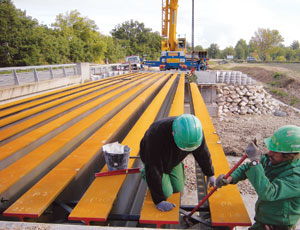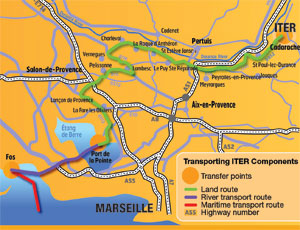Wood, coal, gas and oil have long-fueled societies since prehistoric times but they all emit carbon dioxide and all are finite. Today, rapid economic growth is straining the Earth’s ability to meet demand for these fuels, and rising greenhouse-gas concentrations are threatening the climate’s stability. Clean, renewable energy alternatives are being proposed to replace these fuels, but many have limitations: Wind may not blow when demand is up, the sun shines only part of the day and drought can cripple a hydropower plant. Because fossil fuels are still abundant and relatively cheap, they will continue to provide the bulk of our energy at midcentury, despite promises of other power sources.

Researchers, however, are devoting enormous effort and resources to studying and developing a technology that promises inexhaustible supplies of energy with negligible environmental impact. On a 180-hectare site in Cadarache, France, 60 kilometers north of Marseille, earth-moving equipment has leveled a 60-hectare platform for construction of the International Thermonuclear Experimental Reactor (ITER). Scientists, supported by the funds and contributions-in-kind of seven sponsoring countries representing more than half the world’s population, will use it to demonstrate the feasibility of fueling a prototype electricity-generating plant with burning-plasma fusion. By 2025, ITER should do that with a gain of 10, meaning that an input of 50 MW will produce 500 MW of energy. The gain for the prototype powerplant, to be built in Japan by 2035 or 2040, will be 25.
Site clearing and leveling for the 10-year-long construction project began in spring 2007 and now are substantially complete, says Jerry Sovka, civil construction and site support director for ITER International Fusion Energy Organization, the entity formed to design, construct, procure, operate and decommission the research project. Valerian S.A.S., Sorgues, France, has moved 2.3 million cu meters of material to create the platform, which will contain a complex of about 40 buildings. The research will center on two buildings, called the tokamak hall and the hot cell.
The tokamak is a reactor enclosed in a cryogenic chamber, with a doughnut-shaped vacuum vessel containing the plasma in which the fusion reaction occurs. An electric current will heat deuterium and tritium injected into the vessel to 100 million°C, creating a plasma as the heated isotopes collide and fuse. Their fusion will produce helium, which will be exhausted, and free neutrons. The neutrons will collide with lithium, breeding tritium, which will be injected as fuel, maintaining the reaction (see illustration). Superconductors will create a powerful magnetic field to confine the mixture of ions and electrons to enhance and sustain the fusion. Ultimately, researchers hope to sustain an energy-net-positive reaction for 300-500 seconds for the first time ever.
The tokamak hall will have 1-m to 1.5-m-thick concrete walls for containment of radioactivity and floor slabs 500 mm thick, says Sovka. In a building 100 x 100 m, 50 m tall with a two-level basement at 20 m below grade, it will contain the tokamak, cooling systems, magnets, power systems, cryogenic systems for superconductors and other systems. The concrete-clad hot cell, 40 m wide, 70 m long and 25 m tall, will house equipment for handling radioactive materials.
The foundations will rest on the limestone-based soil, with seismic isolation pads 1 m in diameter and 20 cm thick, designed for 0.7-G ground accelerations, says Sovka. Seismic events are not common, but a 1909 earthquake did reveal fault zones.
Other construction on the site includes support buildings and site infrastructure for power, cooling water, sewers, roads and storage lagoons. The storm drains and lagoons have been completed, and the first support building likely will be a manufacturing plant for large magnets, says Sovka. Eventually, in 2012, a 400-kV transmission line a few kilometers long will be added to double an existing feeder to supply the power needed for the tokamak.
Jacobs Engineering U.K. Ltd., Glasgow, supported by Assystem S.A., Paris, France, has substantially completed a $10-million preliminary architectural and engineering design services contract for the buildings, bringing them to the 30% design stage, says Sovka. After design reviews starting next month, Fusion for Energy, the European Union’s agency responsible for providing the E.U.’s contribution to ITER, will tender for AE design completion. Sovka expects the final AE cost to total $63 million to $95 million, but says details of the procurement strategy are not completely settled.
ITER’s total cost currently is estimated at about $12 billion, of which roughly half is construction cost. Under a joint implementation agreement that took effect in October 2007, China, the E.U., India, Japan, South Korea, Russia and the U.S. share the costs. The E.U. has assumed the bulk of the cost, 46%, with each of the other parties providing 9%. But for the construction, the E.U. is contributing up to half and each of the other parties 10%, giving a 10% contingency.
The contributions are both in cash and in kind. Europe, for example, is supplying the magnet and vacuum vessel, says Sovka. The U.S. is designing the magnet going through the center of the machine to shape the plasma and drive the plasma current, “like the primary of a transformer,” says Ned Sauthoff, project manager of U.S. ITER, the Oak Ridge, Tenn.-based agency coordinating the U.S. contribution to ITER. “It’s globally distributed production,” he adds.
Other U.S. contributions include 20% of the plasma-insulating blanket module, heating systems for the plasma, cooling-water systems for the blanket modules and 15% of the instrumentation used for measuring the plasma. The U.S. contribution totals $1.1 billion.
U.S. ITER now is finishing the design and cost estimate and schedule, which it will present to the ITER Council possibly in November, says Sauthoff. “We’re committed to construct, but now we have to get down to the details. What exactly are we going to construct?” Tokamak construction will begin in 2010 and be complete in 2017.
Some 200 components will arrive from all over the world at the port of Fos, near Marseille (see map). They will be transferred to a barge for delivery to La Pointe, then transferred for haul over a serpentine provincial route to Cadarache, 100 km altogether. French transportation authorities are widening and reinforcing the roads to bear loads of up to 600 tonnes, 47 m long and 9 m wide.
ITER might have been constructed in the U.S. but Congress in 1998 backed out of the collaboration with the E.U., Japan and Russia after spending $400 million, forcing the closure of an ITER research site near San Diego, Calif., that was a leading contender to host the reactor. But first-of-a-kind projects often harbor cost and schedule surprises that threaten their viability, which is especially so in a project with extremely fine tolerances like ITER. The National Compact Stellarator Experiment (NCSX), an ITER-complementary project at the Princeton Plasma Physics Laboratory in New Jersey, was terminated last year because of cost overruns. Its complex geometry, very high forces and fine tolerances made it extremely difficult to assemble without “advances in state-of-the-art CAD tools, metrology, low-magnetic-permeability casting alloys and low-distortion welding, leading to cost and schedule growth,” says Rob Goldston, PPPL director.
But humanity is on a bridge to the energy future. The other end is not yet in sight, but in the rear is the historic reliance on energy sources that are certain to be eventually exhausted. ITER scientists say retreat is not an option.


Post a comment to this article
Report Abusive Comment